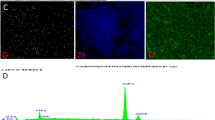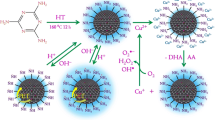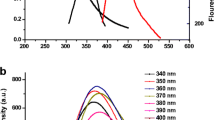Abstract
An one-pot hydrothermal method was developed for synthesis of carbon quantum dots co-doped with copper and nitrogen (Cu, N@CQDs). The synthesized Cu, N@CQDs has unique advantages such as high fluorescence quantum yield (39.1%) and high catalytic activity. Oxidative coupling of amoxicillin (AMX) with 4-aminoantipyrine (4-NH2-APE) in the presence of H2O2 as an oxidant to produce pink quinoneimine chromogen was carried out with the aid of Cu, N@CQDs as a peroxidase-like catalyst. This system was used for the colorimetric and fluorometric assays of AMX with reliable results. Colorimetric method is based on the measurement of a pink-colored product at λmax = 505 nm while the fluorometric assay is based on the quenching of the fluorescence emission of Cu, N@CQDs at 440 nm after excitation at 370 nm. For the colorimetric method, the absorption intensity linearly increased over the concentration range 4.3–110.0 µM with LOD (S/N = 3) of 1.3 µM. For the fluorometric method, the emission intensity of Cu, N@CQDs linearly decreased upon addition of AMX in the concentration range 0.2–120.0 µM with a limit of detection (LOD, S/N = 3) of 0.06 µM. The proposed system was applied to the determination of AMX in different real samples such as pharmaceutical capsules, human serum, milk, and conduit water samples with recoveries in the range 95.8–104.1% and relative standard deviation (RSD %) less than 4.1%.
Graphical abstract










Similar content being viewed by others
References
Mathur S, Fuchs A, Bielicki J, Van Den Anker J, Sharland M (2018) Antibiotic use for community-acquired pneumonia in neonates and children: WHO evidence review. Paediatr Int Child Health 38:S66–S75
Fernández J, Ribeiro IAC, Martin V, Martija OL, Zuza E, Bettencourt AF, Sarasua JR (2018) Release mechanisms of urinary tract antibiotics when mixed with bioabsorbable polyesters. Mater Sci Eng C 93:529–538
Isla A, Trocóniz IF, Canut A, Labora A, Martín-Herrero JE, Pedraz JL, Gascón AR (2011) Pharmacokinetic/pharmacodynamic evaluation of amoxicillin, amoxicillin/clavulanate and ceftriaxone in the treatment of paediatric acute otitis media in Spain. Enferm Infecc Microbiol Clínica 29(2011):167–173
Dousa D, Hosmanova R (2005) Rapid determination of amoxicillin in premixes by HPLC. J Pharm Biomed Anal 37:373–377
Li W, Tan F, Zhao K (2006) Simultaneous determination of amoxicillin and ranitidine in rat plasma by high-performance liquid chromatography. J Pharm Biomed Anal 41:594–598
Tavakoli N, Varshosaz J, Dorkoosh F, Zargarzadeh MR (2007) Development and validation of a simple HPLC method for simultaneous in vitro determination of amoxicillin and metronidazole at single wavelength. J Pharm Biomed Anal 43:325–329
Benito-Pena E, Urraca JL, Moreno-Bondi MC (2009) Quantitative determination of penicillin V and amoxicillin in feed samples by pressurised liquid extraction and liquid chromatography with ultraviolet detection. J Pharm Biomed Anal 49(2009):289–294
Hernandez M, Borrull F, Calull M (1999) Determination of amoxicillin in plasma samples by capillary electrophoresis. J Chromatogr B 731:309–315
Hasanpour F, Ensafi AA, Khayamian T (2010) Simultaneous chemiluminescence determination of amoxicillin and clavulanic acid using least squares support vector regression. Anal Chim Acta 670:44–50
Gabriel M, Valenga P, Felsner ML, Matos CF, Castro EG, A. Galli A, (2020) Development and validation of voltammetric method for determination of amoxicillin in river water. Anal Chim Acta 1138:79–88
Habibi B, Pashazadeh A, Saghatforoush LA (2021) Zn-mesoporous metal-organic framework incorporated with copper ions modified glassy carbon electrode: electrocatalytic oxidation and determination of amoxicillin. Microchem J 164:106011
Alqarni AO, Alkahtani SA, Mahmoud AM, El-Wekil MM (2021) Design of “Turn On” fluorometric nanoprobe based on nitrogen doped graphene quantum dots modified with β-cyclodextrin and vitamin B6 cofactor for selective sensing of dopamine in human serum. Spectrochim Acta Part A: Mol Biomol Spectrosc 248:119180
Ali HRH, Hassan AI, Hassan YF, El-Wekil MM (2021) Colorimetric and fluorometric nanoprobe for selective and sensitive recognition of hazardous colorant indigo carmine in beverages based on ion pairing with nitrogen doped carbon dots. Food Chem 349:129160
Mahmoud AM, Mahnashi MH, Alhazzani K, Alanazi AZ, Algahtani MM, Alaseem A, Alyami BA, AlQarni AO, El-Wekil MM (2021) Nitrogen doped graphene quantum dots based on host guest interaction for selective dual readout of dopamine. Spectrochim Acta Part A: Mol Biomol Spectrosc 252:119516
Liu Y, Duan W, Song W, Liu J, Ren C, Wu J, Liu D, Chen H (2017) Red emission B, N, S-co-doped carbon dots for colorimetric and fluorescent dual mode detection of Fe3+ ions in complex biological fluids and living cells. ACS Appl Mater Interfaces 9:12663–12672
Ali HRH, Hassan AI, Hassan YF, El-Wekil MM (2019) Colorimetric and fluorimetric (dual-mode) nanoprobe for the determination of pyrogallol based on the complexation with copper (II)- and nitrogen-doped carbon dots. Microchem Acta 186:850
Wang Z, Zong S, Li W, Wang C, Xu S, Chen H, Cui Y (2012) SERS-fluorescence joint spectral encoding using organic-metal-QD hybrid nanoparticles with a huge encoding capacity for high throughput biodetection: putting theory into practice. J Am Chem Soc 134:2993–3000
Chen G, Bai W, Jin Y, Zheng J (2021) Fluorescence and electrochemical assay for bimodal detection of lead ions based on Metal-Organic framework nanosheets. Talanta 232:122405
Ali HRH, Hassan AI, Hassan YF, El-Wekil MM (2020) Development of dual function polyamine-functionalized carbon dots derived from one step green synthesis for quantitation of Cu2+ and S2− ions in complicated matrices with high selectivity. Anal Bioanal Chem 412:1353–1363
Mahmoud AM, El-Wekil MM, Mahnashi MH, Ali MFB, Alkahtani SA (2019) Modification of N, S co-doped graphene quantum dots with p-aminothiophenol-functionalized gold nanoparticles for molecular imprint-based voltammetric determination of the antiviral drug sofosbuvir. Microchem Acta 186:617
Lin X, Xiong M, Zhang J, He C, Ma X, Zhang H, Kuan Y, Yang M, Huang Q (2021) Carbon dots based on natural resources: synthesis and applications in sensors. Microchem J 160(part A):105604
Huang Q, Lin X, Chen D, Tong Q (2022) Carbon Dots/α-Fe2O3-Fe3O4 nanocomposite: efficient synthesis and application as a novel electrochemical aptasensor for the ultrasensitive determination of aflatoxin B1. Food Chem 373(part A):131415
Huang Q, Lin X, Tong Q (2020) Graphene quantum dots/multiwalled carbon nanotubes composite-based electrochemical sensor for detecting dopamine release from living cells. ACS Sustainable Chem Eng 8(3):1644–1650
Huang Q, Li Q, Chen Y, Tong L, Lin X, Zhu J, Tong Q (2018) High quantum yield nitrogen-doped carbon dots: green synthesis and application as “off-on” fluorescent sensors for the determination of Fe3+ and adenosine triphosphate in biological samples. Sens Actuat: B Chemical 276:82–88
Delnavaz E, Amjadi M (2021) A chemiluminescence probe enhanced by cobalt and nitrogen-doped carbon dots for the determination of a nitrosative stress biomarker. Microchem Acta 188:278
Jia J, Lu W, Cui S, Dong C, Shuang S (2021) Preparation of yellow-emitting carbon dots and their bifunctional detection of tetracyclines and Al3+ in food and living cells. Microchem Acta 188:418
Li Y, Tang L, Zhu C, Liu X, Wang X, Liu Y (2022) Fluorescent and colorimetric assay for determination of Cu(II) and Hg(II) using AuNPs reduced and wrapped by carbon dots. Microchem Acta 189:10
Liu J, Wu F, Liu C, Bao H, Fu T (2022) “Turn-on” fluorometric probe for α-glucosidase activity using red fluorescent carbon dots and 3,3′,5,5′-tetramethylbenzidine. Microchem Acta 187:498
Wang X, Cheng Z, Zhou Y, Tammina SK, Yang Y (2020) A double carbon dot system composed of N, Cl-doped carbon dots and N, Cu-doped carbon dots as peroxidase mimics and as fluorescent probes for the determination of hydroquinone by fluorescence. Microchem Acta 187:350
Baker SN, Baker GA (2010) Luminescent carbon nanodots: emergent nanolights. Angew Chem Int Ed 49:6726–6744
Tian J, Liu Q, Asiri AM, Qusti AH, Al-Youbi AO, Sun X (2013) Ultrathin graphitic carbon nitride nanosheets: a novel peroxidase mimetic, Fe doping-mediated catalytic performance enhancement and application to rapid, highly sensitive optical detection of glucose. Nanoscale 5:11604–11609
Li LB, Dong T (2019) Photoluminescence tuning in carbon dots: surface passivation or/and functionalization, heteroatom doping. J Mater Chem C 6(30):7944–7970
Park YS, Yoo JH, Lim B, Kwon W, Rhee SW (2016) Improving the functionality of carbon nanodots: doping and surface functionalization. J Mater Chem 4(30):11582–11603
Liu W, Li C, Ren Y, Sun X, Pan W, Li Y, Wang J, Wang W (2016) Carbon dots: surface engineering and applications. J Mater Chem B 4(35):5772–5788
Lin LP, Luo XX, Tsai PY, Wang JJ, Xi C (2018) Metal ions doped carbon quantum dots: synthesis, physicochemical properties, and their applications. Trac Trends Anal Chem 103:87–101
Sun HJ, Wu LI, Wei WL, Qu XG (2013) Recent advances in graphene quantum dots for sensing. Mater Today 16(11):433–442
Vázquez-González M, Liao WC, Cazelles RM, Wang S, Yu X, Gutkin V, Willner I (2017) Mimicking horseradish peroxidase functions using Cu2+-modified carbon nitride nanoparticles or Cu2+-modified carbon dots as heterogeneous catalysts. ACS Nano 11:3247–3253
Zhang Q, Xu W, Han C, Wang X, Wang Y, Li Z, Wu W, Wu M (2018) Graphene structure boosts electron transfer of dual-metal doped carbon dots in photooxidation. Carbon 126:128–134
Yi Q, Ji J, Shen B, Dong C, Liu J, Zhang J, Xing M (2019) Singlet oxygen triggered by superoxide radicals in a molybdenum cocatalytic Fenton reaction with enhanced REDOX activity in the environment. Environ Sci Technol 53:9725–9733
Khashaba PY, Ali HRH, El-Wekil MM (2017) Complexation based voltammetric determination of pantoprazole sodium in pharmaceutical formulations and rabbit plasma. Electroanalysis 29:890–897
Khashaba PY, Ali HRH, El-Wekil MM (2017) Highly sensitive and selective complexation based voltammetric methods for the analysis of rabeprazole sodium in real samples. RSC Adv 7:3043–3050
Mahnashi MH, Mahmoud AM, Alhazzani K, Alanazi AZ, Algahtani MM, Alaseem AM, Alqahtani YSA, El-Wekil MM (2021) Enhanced molecular imprinted electrochemical sensing of histamine based on signal reporting nanohybrid. Microchem J 168:106439
Ali HRH, Hassan AI, Hassan YF, El-Wekil MM (2021) Mannitol capped magnetic dispersive micro-solid-phase extraction of polar drugs sparfloxacin and orbifloxacin from milk and water samples followed by selective fluorescence sensing using boron-doped carbon quantum dots. J Environ Chem Eng 9:105078
El-Wekil MM, Ali HRH, Marzouk AA, Ali R (2018) Synthesis of Fe3O4 nanobead-functionalized 8-hydroxyquinoline sulfonic acid supported by an ion-imprinted biopolymer as a recognition site for Al3+ ions: estimation in human serum and water samples. New J Chem 42:9828–9836
Mahnashi MH, Mahmoud AM, Alkahtani SA, Ali R, M. M. El-Wekil MM, (2020) A novel imidazole derived colorimetric and fluorometric chemosensor for bifunctional detection of copper (II) and sulphide ions in environmental water samples. Spectrochim Acta Part A: Mol Biomol Spectrosc 228:117846
Alyami BA, Mahmoud AM, Alkahtani SA, El-Wekil MM (2021) NiFe2O4 nanospheres functionalized with 2-(2, 4-dihydroxyphenyl)-3, 5, 7-trihydroxychromen-4-one for selective solid-phase microextraction of aluminium. Talanta 226:122167
Guo XL, Ding ZY, Deng SM, Wen CC, Shen XC, Jiang BP, Liang HA (2018) Novel strategy of transition-metal doping to engineer absorption of carbon dots for near-infrared photothermal/photodynamic therapies. Carbon 134:519–530
Liu Y, Wu P, Wu X, Ma C, Luo S, Xu M, Li W, Liu S (2020) Nitrogen and copper (II) co-doped carbon dots for applications in ascorbic acid determination by non-oxidation reduction strategy and cellular imaging. Talanta 210:120649
Mohamed FA, Khashaba PY, Shahin RY, El-Wekil MM (2019) Tunable ternary nanocomposite prepared by electrodeposition for biosensing of centrally acting reversible acetyl cholinesterase inhibitor donepezil hydrochloride in real samples. Colloids Surf A: Physicochem Engin Asp 567:76–85
Duan Y, Huang Y, Chen S, Zuo W, Shi B (2019) Cu-doped carbon dots as catalysts for the chemiluminescence detection of glucose. ACS Omega 4:9911–9917
Liu P, Hensen EJM (2013) Highly efficient and robust Au/MgCuCr2O4 catalyst for gas-phase oxidation of ethanol to acetaldehyde. J Am Chem Soc 135:14032–14035
Liu H, Zhang Y, Liu JH, Hou P, Zhou J, Huang CZ (2017) Preparation of nitrogen-doped carbon dots with high quantum yield from Bombyx mori silk for Fe (III) ions detection. RSC Adv 7(80):50584–50590
Pourreza N, Ghomi M (2019) Green synthesized carbon quantum dots from Prosopis juliflora leaves as a dual off-on fluorescence probe for sensing mercury (II) and chemet drug. Mater Sci Engin C 98:887–896
Aljeboree AM, Alshirifi AN (2019) Colorimetric determination of Amoxicillin using 4-Aminoantipyrine and the effects of different parameters. J. Phys: Conf Ser 1294:052067
Li G, Fu H, Chen X, Gong P, Chen G, Xia L, Wang H, You J, Wu Y (2016) Facile and sensitive fluorescence sensing of alkaline phosphatase activity with photoluminescent carbon dots based on inner filter effect. Anal Chem 88:2720–2726
Huang S, Wang L, Huang C, Xie J, Su W, Sheng J, Xiao Q (2015) A carbon dots based fluorescent probe for selective and sensitive detection of hemoglobin. Sens Actuat B Chemical 221:1215–1222
Svobodová D, Gasparič J (1971) Investigation of the colour reaction of phenols with 4-aminoantipyrine. Microchimica Acta 59:384–390
Zhai W, Wang C, Yu P, Wang Y, Mao L (2014) Single-layer MnO2 nanosheets suppressed fluorescence of 7-hydroxycoumarin: mechanistic study and application for sensitive sensing of ascorbic acid in vivo. Anal Chem 86:12206–12213
Ettinger M, Ruchhoft C, Lishka R (1951) Sensitive 4-aminoantipyrine method for phenolic compounds. Anal Chem 23(12):1783–1788
Akhond M, Absalan G, Ershadifar H (2015) Highly sensitive colorimetric determination of amoxicillin in pharmaceutical formulations based on induced aggregation of gold nanoparticles. Spectrochim Acta Part A Mol Biomol Spectrosc 143:223–229
Ain N, Anis I, Ahmed F, Shah MR, Parveen S, Faizi S, Ahmed S (2018) Colorimetric detection of amoxicillin based on querecetagetin coated silver nanoparticles. Sens Actuat B: Chemical 265:617–624
Pawar SP, Walekar LS, Gunjal DB, Dalavi DK, Gore AH, Anbhule PV, Patil SR, Kolekar GB (2017) Fluorescence-based sensor for selective and sensitive detection of amoxicillin (Amox) in aqueous medium: application to pharmaceutical and biomedical analysis. Luminescence 32:918–923
Chen W, Hong L, Liu AL, Liu JQ, Lin XH, Xia XH (2012) Enhanced chemiluminescence of the luminol-hydrogen peroxide system by colloidal cupric oxide nanoparticles as peroxidase mimic. Talanta 99:643–648
Swaidan A, Barras A, Addad A, Tahon JF, Toufaily J, Hamieh T, Szunerits S, Boukherroub R (2021) Colorimetric sensing of dopamine in beef meat using copper sulfide encapsulated within bovine serum albumin functionalized with copper phosphate (CuS-BSA-Cu3(PO4)2) nanoparticles. J Colloids Interf Sci 582:732–740
Xiao J, Rabeah J, Yang J, Xie Y, Cao H, Brückner A (2017) Fast electron transfer and •OH formation: key features for high activity in visible-light-driven ozonation with C3N4 catalysts. ACS Catal 7:6198–6206
Li D, Tong Y, Huang J, Ding L, Zhong Y, Zeng D, Yan P (2011) Preparation of magnetic core-shell nanoflowers Fe3O4@MnO2 as reusable oxidase mimetics for colorimetric detection of phenol. J Mol Catal A: Chem 345:108–116
Niu X, He Y, Pan J, Li X, Qiu F, Yan Y, Shi L, Zhao H, Lan M (2016) Uncapped nanobranch-based CuS clews used as an efficient peroxidase mimic enable the visual detection of hydrogen peroxide and glucose with fast response. Anal Chim Acta 947:42–49
Wu S, Guo D, Xu X, Pan J, Niu X (2020) Colorimetric quantification and discrimination of phenolic pollutants based on peroxidase-like Fe3O4 nanoparticles. Sens Actuat: Chemical B 303:127225
Li DP, Tong YL, Huang J, Ding LY, Y.M. Zhong YM, D. Zeng D, Yan P, (2011) First observation of tetranitro iron(II) phthalocyanine catalyzed oxidation of phenolic pollutant assisted with 4-aminoantipyrine using dioxygen as oxidant. J Mol Catal A Chem 345:108–116
Acknowledgements
The authors are thankful to the Deanship of Scientific Research at Najran University for funding this work under the General Research Funding Program grant code [NU-RC-MRC-11-3].
Author information
Authors and Affiliations
Corresponding author
Ethics declarations
Conflict of interest
The authors declare no competing interests.
Additional information
Publisher's note
Springer Nature remains neutral with regard to jurisdictional claims in published maps and institutional affiliations.
Supplementary Information
Below is the link to the electronic supplementary material.
Rights and permissions
About this article
Cite this article
Mahmoud, A.M., El-Wekil, M.M., Ali, R. et al. Double-signal quantification of amoxicillin based on interaction with 4-aminoantipyrine at copper and nitrogen co-doped carbon quantum dots as an artificial nanozyme. Microchim Acta 189, 183 (2022). https://doi.org/10.1007/s00604-022-05253-1
Received:
Accepted:
Published:
DOI: https://doi.org/10.1007/s00604-022-05253-1




